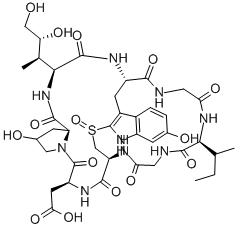peritoneal-mouse LD50: 0.4 mg/kg; unnamed-mouse LD50: 0.4 mg/kg
β-Amanitin from
Amanita phalloides has been used:
- as a calibration standard for the quantification of β-Amanitin using liquid chromatography-high resolution-mass spectrometry/mass spectrometry (LC-HR-MS/MS) method.
- to determine its concentration in urine samples by capillary zone electrophoresis (CZE).
- in the analysis of β-amanitin in toxic mushrooms by liquid chromatography coupled to time-of-flight mass spectrometry.
β-Amanitin is a cyclic peptide found in several species of the Amanita genus, as well as other poisonous fungi. It inhibits RNA polymerase II and III but not RNA polymerase I or bacterial RNA polymerase, thus preventing mammalian protein synthesis. The biological activity of this toxin is similar to that of α-amanitin but differs structurally by the presence of a carboxyl group, which is useful for coupling reactions.
As a tool in molecular biology.
β-Amanitin belongs to the family of amatoxins. Amanitins are made of bicyclic octapeptides. β-Amanitin is composed of a carboxyl group and is acidic in nature.
Toxic constituent of the mushroom, Amanita phalloides, inhibits eukaryotic RNA polymerase II and III, but not RNA polymerase I or bacterial RNA polymerase. Inhibits mammalian protein synthesis.

